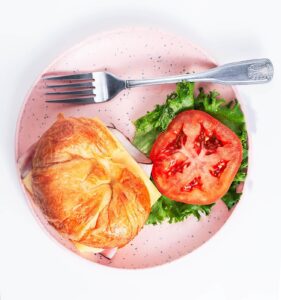INTRODUCTION
Great food photography can do a lot of things! It can stir up your viewers’ appetites, persuade diners to place an order and help you sell insane amounts of food and recipe books. Effective food photography involves visual storytelling, and a proper description of the dish’s origins, preparation method, expected flavors, and textures. A food photographer tells a story using lighting, composition, and styling that captivates the spectator and entices them to try the dish.

Simply put, food photography is a fantastic chance to connect with people who share your enthusiasm for cooking, explore your creativity, and enjoy trying new methods. Food photography has something to offer everyone, whether you’re a hobbyist or a professional photographer. In this article, you will discover how to capture food photos like a pro.
FOOD PHOTOGRAPHY CHALLENGES
- Catch It If You Can
Food may dissolve rapidly, melt, cool, fade, and other ways. Your first attempt at photographing ice cream will give you a good idea of why food poses such a photographic difficulty. Or even “not so solid.” You have roughly five minutes before a pool of melted cream covers your background or surface. Indeed, the cheese on a pizza is melted only for a short while outside of the oven. Do you want to capture the lovely steam rising from your steaming tea? You underestimate how much labor that will take.
- Can Be So Boring
Food can be flat, dull, and uninspiring, with nothing exciting to talk about. What is the food model I find most frustrating? A dilemma. Sounds good, but the neutral colors of tortillas and cheese sure make it more difficult. You’ll know what I mean if you’ve ever done it.
- Composition
Composition is a crucial skill necessary for all forms of photography to produce outstanding shots. Particularly when it comes to food photography. Understanding the subtleties of food can be difficult.
The shapes that can be found in food photography are endless. The food comes first, followed by the plates, linens, surfaces, extras, and props. In and of itself, setting up a shot so that it flows is an artistic endeavor.
Capturing mouthwatering food photos requires skill. The food stylist must carefully construct each scene to enhance the main dish without creating clutter. Thoughtful styling adds depth and interest to pictures without it being distracting.
Proper composition leads the viewer’s eye to focus right where you want it. The arrangement of elements in the frameworks together tells a visual story and conveys the tone you wish to achieve. With good composition, you can highlight the appetizing qualities that make someone want to grab a bite through the photo! Careful consideration of lighting, angles, props, and other photographic elements will result in an image that captures the essence of the food and draws people in.
4 WAYS TO IMPROVE YOUR FOOD PHOTOGRAPHY
- Find Your Angles
You’ll see a trend if you examine enough expert food photos. The two joint angles frequently used are the flat-lay shot from above and the low-over-the-table shot from the side. You should start your composition from these viewpoints. Rather than randomly choosing one, take the time to carefully consider what angle will work best for your shot.
Why? Because the kind of tale you tell will depend on where you position the camera. As you arrange your composition, keep the food in mind. Please take note of its dimensions, form, height, and distinctive features. Then, position the camera to emphasize these attributes best.
- Focus on the hero object and surround it
A hero object or the main subject of your photo shoot that you wish to draw attention to. Setting this up correctly is the first step in creating a basic setup for food photography. It is typically the main course. Hence, you must decide on your hero item now. Set it down on the table. After that, envelop it with food-related objects. Cooking equipment, oils, sauces, and ingredients can all reveal how a dish was prepared. Herbs, glasses, tins, linens, and fabrics can all give away where a dish comes from or what season it is served.
Place a few objects in the background and front, but don’t go crazy. These will enhance the shot’s narrative and add genuine dimension to your composition.
- Natural Light Is Your Friend
One of the keys to food photography is light. Ineffective lighting design will detract from your images and alienate viewers. However, you can quickly elevate your food photographs to a new level if you can figure out how to regulate the light. Putting a diffuser between the food and the window is the first thing to do, especially when working in direct sunlight.
You see, dazzling highlights and solid and dark shadows are created by direct sunshine. These can be overpowering, but you can soften the light, lessen the highlights and shadows, and create a beautiful effect by adding a diffuser. Just in case you are wondering, diffusers are inexpensive and easily purchased from any photographic supply store, but you may also create your own by simply hanging a thin white bedsheet in front of the window.
- Add a touch of oil or spray the food with water
Professional food photography creators often add a touch of oil or spray the food with water. This trick will make your images pop, making your food look more attractive to the customer. It takes some experimenting, but once you have assembled the perfect dish and applied oil or water, you can create some exceptional pictures.
Make use of your knowledge!!!!
Now that you’ve finished this article, you know how to photograph food like a pro – so you’re ready to start capturing some stunning food photos that will make people lick their lips. Just remember to always pay careful attention to the light and the composition. That way, your cooking photos can shine!